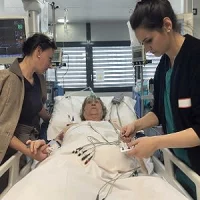A Johns Hopkins-led study on sedation practices in critically ill patients in a resource-limited setting finds that deep sedation, agitation, and benzodiazepines were independently associated with worse clinical outcomes. The study's main objective was to determine the relationship between sedation status and 90-day mortality.
Study results show that a greater percentage of days spent in deep sedation was associated with a fivefold greater odds of mortality, while agitation status had a 40-fold higher mortality; benzodiazepine usage was associated with a 41% higher odds of 90-day mortality.
The results indicate that despite strong evidence that correlates sedation depth with worse clinical outcomes, most ICU patients were deeply sedated during their ICU stay. This high level of sedation could potentially account for the high mortality observed in the study's cohort and warrants timely sustainable implementation strategies that apply to low- and middle-income countries, such as standardised protocols.
This study of critically ill participants on mechanical ventilation (n = 1,657) was conducted in five intensive care units (ICUs) in four public hospitals in Lima, Peru. Investigators observed that most of the study participants were deeply sedated throughout their ICU stay. The most commonly used sedatives were opioids and benzodiazepines. The overall cumulative dose of benzodiazepines and opioids was high, 774.5 mg and 16.8 g, respectively, by day 7 and by day 28; these doses approximately doubled.
As shown in this study, Peruvian ICUs mainly use benzodiazepines and opioids, and the use of dexmedetomidine is still limited. One of the reasons for the low usage of dexmedetomidine could be its high price; however, when considering the potential benefits, it is possible that it may actually be more cost-effective than using benzodiazepines.
In addition, the study showed that the use of haloperidol was associated with a lower mortality in ICU patients. Even though investigators did not assess delirium directly in ICU patients, they used haloperidol as a surrogate for the treatment of ICU delirium. Previous evidence shows that the use of antipsychotics could reduce the incidence of delirium. The effect of delirium management with antipsychotic medications on mortality in critically ill patients is unknown, and adequately powered randomised control trials are needed.
Interestingly, none of the five ICUs participating in this study used protocols for sedation management, nor did they use tools to screen or manage delirium. This is not surprising since data from previous international surveys reported implementation rates between 20% and 80%, including a study of 912 ICU practitioners in high-income countries that revealed that only 16% used a valid delirium assessment tool.
Optimising sedation practices and delirium screening with the use of protocols is associated with improved patient-centred outcomes such as a lower incidence of delirium, fewer days on mechanical ventilation, and an overall reduction in mortality. Additionally, standardised management of sedation reduces the use of sedatives without negatively affecting patient safety or increasing psychological stress.
Source: Critical Care
Image Credit: iStock
References:
Aragón RE et al. (2019) Sedation practices and clinical outcomes in mechanically ventilated patients in a prospective multicenter cohort. Critical Care 23:130 https://doi.org/10.1186/s13054-019-2394-9
Latest Articles
ICU, sedation, critically ill patients, deep sedation, agitation, benzodiazepines
A Johns Hopkins-led study on sedation practices in critically ill patients in a resource-limited setting finds that deep sedation, agitation, and benzodiazepines were independently associated with worse clinical outcomes. The study's main objective was to










